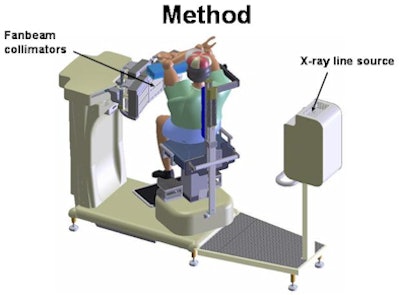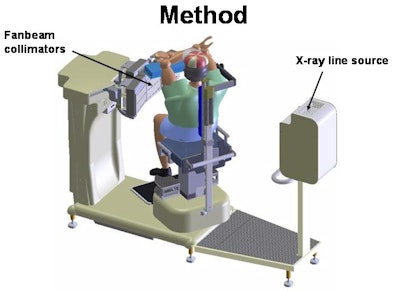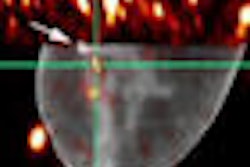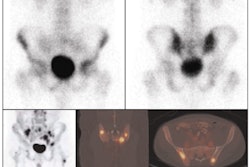
Researchers from the University of California, Los Angeles (UCLA) and nuclear medicine firm Digirad of Poway, CA, are developing a new x-ray-based transmission approach for attenuation correction in cardiac SPECT, which shows that high-quality transmission scans can be completed within one minute and with negligible patient dose.
Citing previous research, Richard Conwell, senior vice president of technology at Digirad, noted that soft-tissue attenuation is the most important artifact in myocardial perfusion SPECT imaging, in that it "alters the absolute and relative measurements of the pharmaceutical uptake, obstructs the shape of the ventricle, and dominates all other competing artifacts." To correct for the artifact, an attenuation map and SPECT reconstruction marker are required.
One option is to use a uniform map, where no measurement is necessary, but Conwell noted that the method has not been entirely accurate for SPECT myocardial perfusion imaging.
A second way is to use a nonuniform map, which utilizes an isotopic transmission source whereby the gamma camera acts as the detector. A limitation, however, is that it can produce "a noisy transmission image due to the mean counting rate limitations of the Anger camera detector itself," Conwell said in his presentation at the annual SNM meeting.
Less maintenance
"In addition, most of the isotopic sources that have been used require annual replacement or perhaps annual refurbishment," Conwell said. "Today, with the dedicated small footprint of small field-of-view cameras, often times these cardiology cameras using a transmission isotopic attenuation correction can have truncated scans."
With the combination of CT with gamma cameras, computation of an attenuation map can be accomplished through the CT scanner, but again, there are some limitations. "First of all, you have two separate imaging systems," Conwell said. "Although there may be a common palette between the systems, often times you can have coregistration problems with the images. In addition, with the multislice and 64-slice machines, they are often so fast that they actually only capture a portion of the respiratory side. You can have a problem aligning that image with your emission image, which is typically acquired over many respiratory cycles."
Additionally, radiation dose is also an issue with multislice CT systems.
With that in mind, researchers at UCLA and Digirad set out to develop a system with a low-noise transmission map that did not require replacement of isotopic sources and featured very low dose to the patient of 10 µSv or less. The system has to image quickly, "but not too fast, because we don't want to freeze a respiratory cycle. We want to integrate over several respiratory cycles," Conwell said. "Then, ideally we would want to add coregistered emission transmission images intrinsically. A good way to do that is to have a common detector for both images."
Shorter imaging time
The group also aimed for a short time period between the CT and SPECT images to decrease the chance of patient motion.
Working with a Digirad Cardius 3 triple-head, upright rotating SPECT camera with fanbeam collimators, researchers combined a low-dose x-ray generator with high-count-rate-capable solid-state detectors for both transmission and emission scans. The configuration enables attenuation maps to be obtained with minimal increase in total study time and with insignificant added dose to the patient.
 |
| This illustration shows the works-in-progress SPECT system with the position of the x-ray source, fanbeam collimators, and patient. Image courtesy of Digirad. |
For transmission scans, a collimated line source was found using an x-ray generator and positioned at the focal line of the collimators. The camera could handle count rates greater than 12 Mcps, which allowed transmission scans to be finished in 30 seconds.
In phantom studies, researchers found high-quality attenuation maps and improved uniformity in the image of the cardiac insert with attenuation correction, compared to the image without attenuation correction. In addition, the transmission dose was less than an equivalent injected dose of 5 uCi of technetium-99m.
Attenuation correction process
In describing the process, Conwell said a technologist manually sets the detector heads to the transmission position. An x-ray line source and fanbeam collimators are aligned with the line source to create the focal point. The technologist then turns on the x-ray beam and the system rotates around the patient to create a 202° image over 60 seconds.
"Essentially, what were the emission detectors are operating as a low resolution 24-slice CT at this point," Conwell said. "Because the system does not translate between the emission and the transmission positions, the patient's weight is always in the same location, which is not the case often times when you translate the palette on the SPECT/CT system; you get some vertical deflection. This has been found to be one of the major reasons for misregistration in SPECT/CT systems."
By combining the solid-state gamma camera detector with the x-ray source, the researchers say they have created a volumetric CT system that produces scans with high count statistics and, therefore, produces a quality, nontruncated attenuation map.
"It is safe with very low dose to the patient," Conwell added. "The system also has the feature of a very short time between transmission and emission, with a 60-second transmission scan."
In addition, by using the fluoroscopic x-ray source, the group believes it has eliminated the need to replace isotopic sources.
By Wayne Forrest
AuntMinnie.com staff writer
August 15, 2008
Related Reading
Israeli group test-drives 64-slice SPECT/CT system for cardiac imaging, June 6, 2007
Instrumentation, attenuation correction steer nuclear cardiology's future, October 23, 2006
SPECT/CT implementation: More than plug and play, June 7, 2006
Cardiac SPECT/CT fusion captures SNM's Image of the Year, June 6, 2006
Copyright © 2008 AuntMinnie.com




















